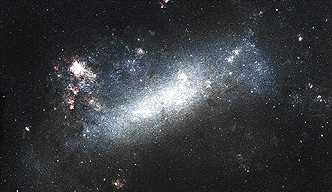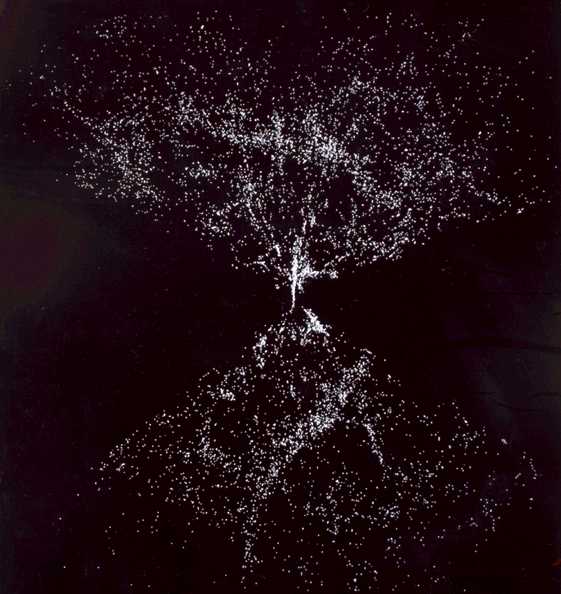Galaxies
and Actual Clusters
The actual galaxies are classified as ellipticals
(like M87), spirals (like the Milky Way or the Andromeda galaxy), lenticulars
(endowed with a disk but
missing spiral arms) and irregulars (like
M82 in Ursa Majoris), being the spirals split in ordinary and barred spirals.
Each spiral is still classified according to the proportional size that the central bulge assumes in the galactic bulk (bigger bulges imply
smaller paces of stellar formation, closer to those seen in the ellipticals)
and each elliptical according to the more or less pronounced flatness
(disproportion between the bigger and the smaller axis). The galaxies may still
be classified according to their size, like the dwarfs (with diameters
measuring a few hundred light years), the giants (with halos that may reach millions light years and overlay the neighbouring
galaxies' halos) or intermediate sized galaxies like the Milky Way.

E0-E7 (to the left):
ellipticals, S0 (in the intersection): lenticulars, Sa-Sc (at the top):
ordinary spirals, SBa-SBc (at the bottom): barred spirals (MoonRunner Design
UK)

M87 in the centre or
the Virgo cluster: giant elliptical galaxy (AAO)

Sombrero:
lenticular galaxy (AAO)

M83: spiral galaxy (AAO)

NGC1365: barred spiral
galaxy (AAO)
Evolutionary
Divergences between Spirals and Ellipticals
The Collapse Velocity
One model advocates that what determined the split
between spiral and elliptical galaxies was the velocity at which the
proto-galactic clouds collapsed, which was in turn controlled by the speed of
the conversion of the gas into stars.
In spiral galaxies, the rotation provides to the
matter of the disk a centrifugal force
that prevents it (like those located outside the rotation plane) from directly
falling into the core, contrarily to what happens to the materials located
outside the rotation plane. This way, this kind of galaxies gradually assumes a
discoid shape.
Bu, if the galactic gas is quickly transformed into
stars, the collapse of the outer layers of the galaxy is braked much earlier,
no matter the distance at which they are from the rotation plane.
Alternative Models
An alternative theory defends that some elliptical
galaxies might have been formed as a consequence of collisions between spirals,
which can eventually be supported in some observations that suggest the
existence of a higher proportion of spiral galaxies in the primitive Universe than in the actual one. The observation of a higher
proportion of ellipticals in the dense cores of the galactic clusters also
supports this idea. The collisions between galaxies are also a mechanism
invoked to explain the formation of irregular galaxies.
Recently it has been also advocated that the arising
of a spiral or an elliptical galaxy may depend on the speed at which the supermassive black
holes are formed in its interior.
Distribution
of the Galaxies
The galaxies tend to concentrate in clusters that in
turn tend to concentrate in galactic superclusters.
The Local Group
The Milky Way belongs to the so-called Local Group,
which also includes the spiral galaxies of Andromeda (the only big galaxy that,
in the expanding Universe, gets closer to the
Milky Way) and Triangulum, along with other galaxies with smaller dimensions,
like the Magellanic Clouds.

The Large Magellanic
Cloud, a member of the Local Group: an irregular galaxy (AAO)
Classification and Stratification of the Clusters
Among the clusters two types can be distinguished:
- The regular clusters, with a central core
and a well-defined spherical structure. Its dimensions may vary between 3
and 30 million light years.
- The irregular clusters, like the Virgo
cluster, missing a well-defined centre and with similar dimensions,
though more rarefied.
As it was already mentioned, the elliptical galaxies
tend to concentrate and to be more massive in the clusters' cores, in
opposition to the spirals, which prevail in the outskirts.

The Virgo cluster
(Cambridge Cosmology)
Superclusters
The superclusters are huge structures containing
several clusters and may reach dimensions of about 300 million light years,
like the one in Coma Berenices. The supercluster to which the Milky Way belongs
is called the supercluster of Virgo and is more modest, with an extension of
about 50 million light years. About 90% of all the galaxies are detected inside
this kind of structures.

The Coma Berenices
cluster, which is the core of the supercluster named after it (Cambridge
Cosmology)
Filaments and Big Voids
At an even larger scale we find galaxies distributed
along long sheets or filaments, bordered by big voids that hold average
dimensions of about 75 million light years, but some of them, like the Bootes
void, may reach more than 400 million light years. It's estimated that the big
voids occupy about 90% of the space.

Structure of the
Universe in a large scale, where are visible the long filaments and the big
voids (CfA)
The Size of the Universe
At last, if the inflation theory of Alan Guth is true,
it is estimated that the whole Universe may be about 1050 times
bigger than the visible Universe (which is a sphere extending as far as about
13,7 billion light years from us). If, however, it is confirmed that the Universe
is open, then it shall assume an infinite
size.
_